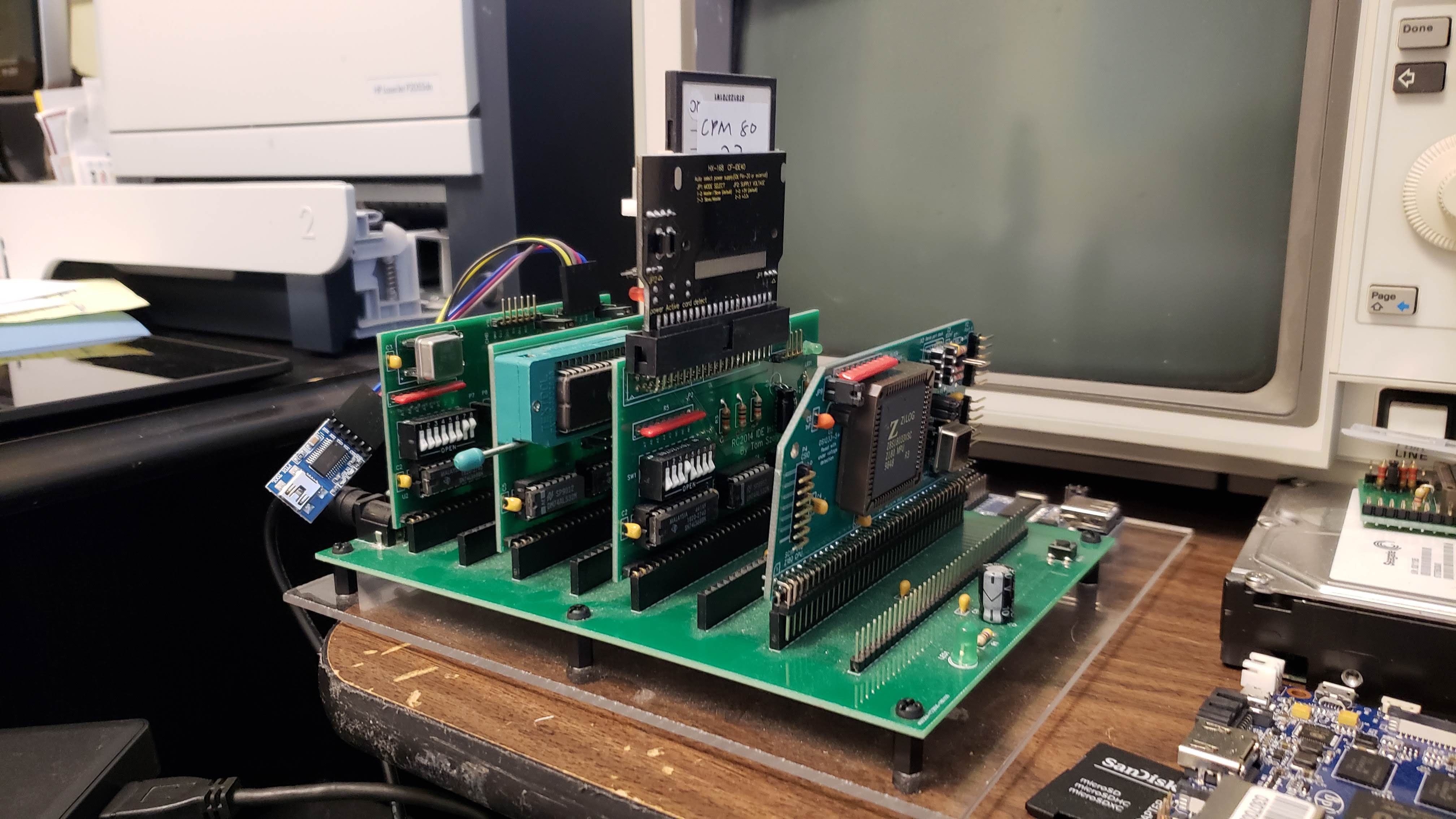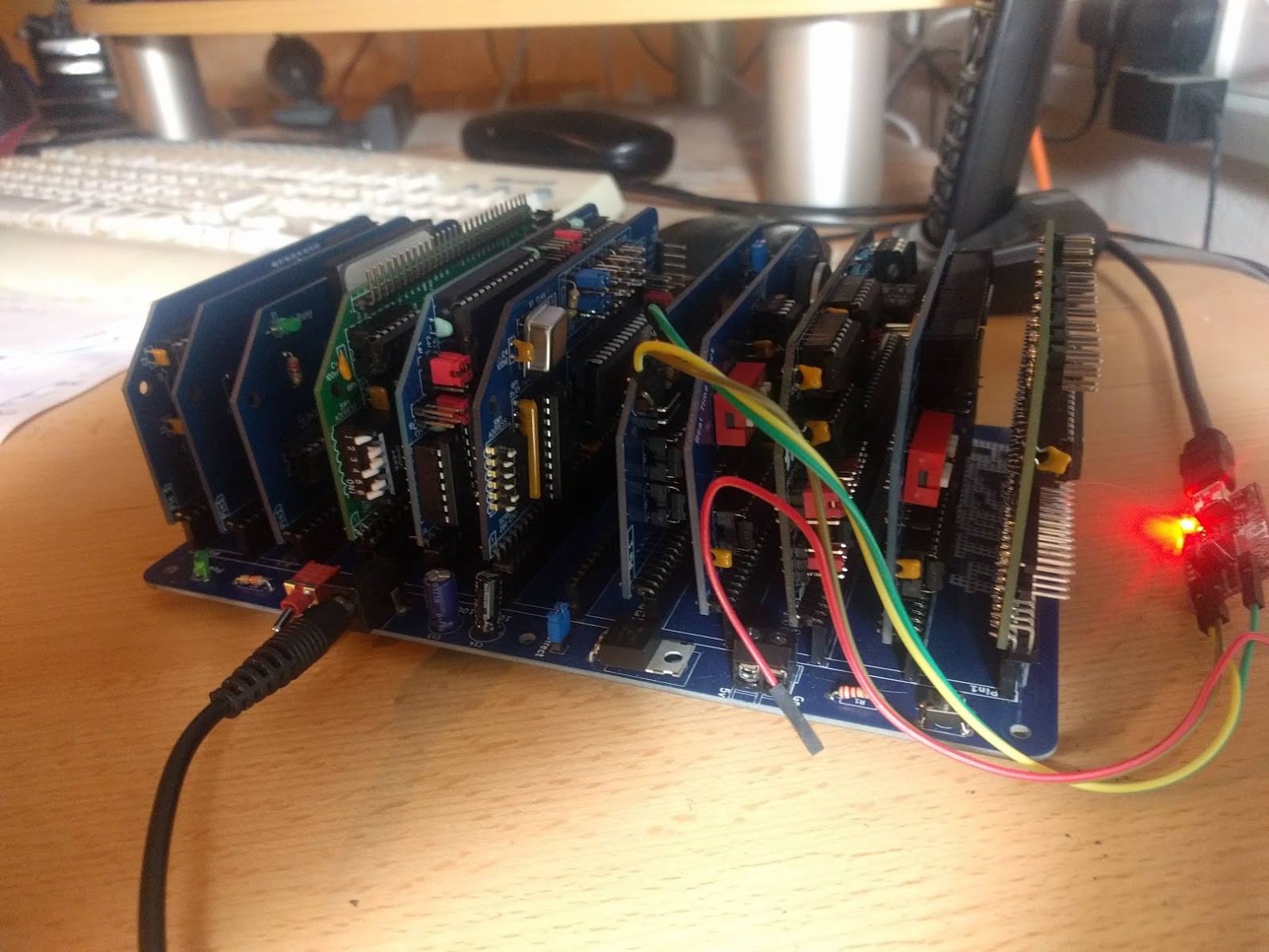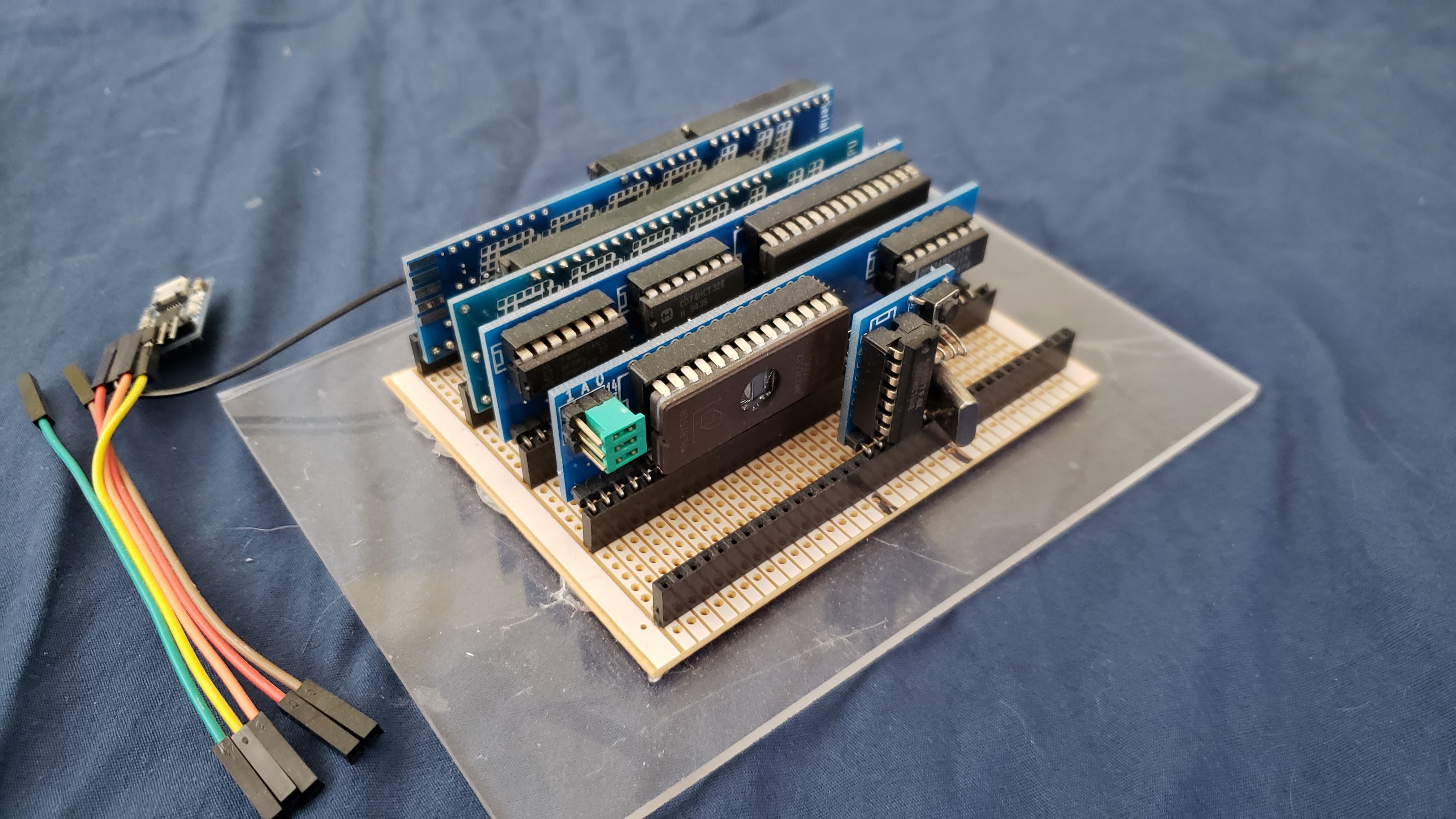![]() LOL It's not Western Digital.. It's Western Design Center
LOL It's not Western Digital.. It's Western Design Center
 Western Digital is the storage Co. It's Western Design Center ;-)
Western Digital is the storage Co. It's Western Design Center ;-)
 (and 6502, 6809, 68000)
(and 6502, 6809, 68000)
 (and 8085)
(and 8085)
 (Used to work for Western Digital!)
(Used to work for Western Digital!)
![]() Right, Western Design Center.
Right, Western Design Center.
 @Bil Herd oh, yes. The 6845 and 6847. Love those devices.
@Bil Herd oh, yes. The 6845 and 6847. Love those devices.
 @epooch Tindie has been absolutely perfect for me. In fact, if it wasn't for the Tindie platform, I think i'd probably still be a network engineer!
@epooch Tindie has been absolutely perfect for me. In fact, if it wasn't for the Tindie platform, I think i'd probably still be a network engineer!
 @Kevin I've heard of the 6845, but what's a 6847?
@Kevin I've heard of the 6845, but what's a 6847?
 Or as we call WDC the BMC, (Bill Mench Company)
Or as we call WDC the BMC, (Bill Mench Company)
 6847 was a composite NTSC video chip, it didn't get as much airtime but really made you drool in the days of TVs as mnitors.
6847 was a composite NTSC video chip, it didn't get as much airtime but really made you drool in the days of TVs as mnitors.
 @Kevin I am familiar with the 6845 from my BBC Micro days..
@Kevin I am familiar with the 6845 from my BBC Micro days..
 I also have my own 68000 CPU board done quite a few years ago. My design but a friend of mine wired it up for me (point to point). It runs at 8MHz. I've finally bought a 68B50 that will allow me to run the CPU at 10MHz.
I also have my own 68000 CPU board done quite a few years ago. My design but a friend of mine wired it up for me (point to point). It runs at 8MHz. I've finally bought a 68B50 that will allow me to run the CPU at 10MHz.
 What would you recommend or advice for implementing a CPU on an FPGA for the first time?
What would you recommend or advice for implementing a CPU on an FPGA for the first time?
![]() @marten Awesome! It looks a bit like my Z280 board except that I turned the Z280 through 45 degrees. The result is so ugly I call it the Coyote280 :-)
@marten Awesome! It looks a bit like my Z280 board except that I turned the Z280 through 45 degrees. The result is so ugly I call it the Coyote280 :-)
 @Bil Ah.. that's why - we're in PAL over here. (UK)
@Bil Ah.. that's why - we're in PAL over here. (UK)
 The really nice thing about the modular nature of the RC2014 though, is the community have really taken it to heart, and started designing their own modules for it. There's now well over 100 boards out there which were designed to fit the RC2014 ecosystem :-)
The really nice thing about the modular nature of the RC2014 though, is the community have really taken it to heart, and started designing their own modules for it. There's now well over 100 boards out there which were designed to fit the RC2014 ecosystem :-)
![]() MC6847 VDU was in the acond atom as well wasn't it?
MC6847 VDU was in the acond atom as well wasn't it?
![]() @Rudranand Sahu start from scratch
@Rudranand Sahu start from scratch
 19: and the Tandy MC10, Dragon 32/64, COCO, COCO2
19: and the Tandy MC10, Dragon 32/64, COCO, COCO2
 @spencer I like the modular design you came up with for the RC2014. I also noticed the adapter for a Pi. :)
@spencer I like the modular design you came up with for the RC2014. I also noticed the adapter for a Pi. :)
 opencores.org is where I go for existiing CPU in FPGA cores
opencores.org is where I go for existiing CPU in FPGA cores
 @spencer is the RC2014 your sole biz or do you do other things too?
@spencer is the RC2014 your sole biz or do you do other things too?
![]() I've got a book about old cathode ray tube controllers, inc. 6845.
I've got a book about old cathode ray tube controllers, inc. 6845.
 @Lex Landa PAL didn't look good even when set for the right mode/clock
@Lex Landa PAL didn't look good even when set for the right mode/clock
![]() Three things every engineer should do: grow their own transistor, implement a CPU at an RTL level, and port a high level compiler to it
Three things every engineer should do: grow their own transistor, implement a CPU at an RTL level, and port a high level compiler to it
![]() do you do much FPGA retro implentation @Bil Herd ?
do you do much FPGA retro implentation @Bil Herd ?
 @Kevin Thanks :-) Yes, the Pi Zero module was one of the first I made for it. It's the cheapest way to convert serial data in to HDMI :)
@Kevin Thanks :-) Yes, the Pi Zero module was one of the first I made for it. It's the cheapest way to convert serial data in to HDMI :)
 :)
:)
 Put you link for the ecosystem. :)
Put you link for the ecosystem. :)
 @spencer what's the craziest rc2014 board you've sene
@spencer what's the craziest rc2014 board you've sene
 s/ene/een
s/ene/een
 @Linker3000 For 3 years now the RC2014 has been my only source of income #LivingTheDream :-)
@Linker3000 For 3 years now the RC2014 has been my only source of income #LivingTheDream :-)
 @Bil Herd Yes, as I recall, the aspect ratio was a bit strange.
@Bil Herd Yes, as I recall, the aspect ratio was a bit strange.
 @AlanH - I've got a 1940's vintage germanium diode I plan to turn into a transistor. Does that count?
@AlanH - I've got a 1940's vintage germanium diode I plan to turn into a transistor. Does that count?
 ah SED or PERL (feels like Rodgers when he gets a flying money reference)
ah SED or PERL (feels like Rodgers when he gets a flying money reference)
 Greetings, I bought an old 64 pin micro in a big ceramic and gold package recently. Hope to build it into something retro some day. Though I got it mainly to admire it looks.
Greetings, I bought an old 64 pin micro in a big ceramic and gold package recently. Hope to build it into something retro some day. Though I got it mainly to admire it looks.
 Basic RC2014 Module specs are here; http://rc2014.co.uk/1377/module-template/
Basic RC2014 Module specs are here; http://rc2014.co.uk/1377/module-template/
 PAL had stripes, they never got the color clock phase inversion correct is my memory.
PAL had stripes, they never got the color clock phase inversion correct is my memory.
![]() @David Richards Do you know which it is?
@David Richards Do you know which it is?
 @spencer How long did the development take before you were felt it was ready for others to buy and use?
@spencer How long did the development take before you were felt it was ready for others to buy and use?
![]() @spencer You use bank switching with the large RAMs. How does that integrate with the software? Can you run an RTOS of some kind on it?
@spencer You use bank switching with the large RAMs. How does that integrate with the software? Can you run an RTOS of some kind on it?
![]() *cough* RC2020 w/ a 68020 *cough*
*cough* RC2020 w/ a 68020 *cough*
 Ah the MMU question :)
Ah the MMU question :)
![]() I've recently started playing around with my terasic DE0-NANO board...man that's a whole new level of programming and system design.
I've recently started playing around with my terasic DE0-NANO board...man that's a whole new level of programming and system design.
Took me a month just to get the basics started and working.
![]() Well, there are at leat some RTOS source codes available for the Z180
Well, there are at leat some RTOS source codes available for the Z180
 Thank you @AlanH, BTW which compiler is most beginner friendly to be modified to add a new architechture?
Thank you @AlanH, BTW which compiler is most beginner friendly to be modified to add a new architechture?
![]() a shift register and some leds shifting to right and when reaching the last bit shifting them back to the left
a shift register and some leds shifting to right and when reaching the last bit shifting them back to the left
 I have three Xilinx FPGA boards. Easy to get the flashing LED going. FPGA's are a whole new ball game.
I have three Xilinx FPGA boards. Easy to get the flashing LED going. FPGA's are a whole new ball game.
 @EtchedPixels I don't think any of the modules have been particulaly crazy. But I did release this one a couple of years ago https://www.tindie.com/products/semachthemonkey/rc2014-googley-eye-module/
@EtchedPixels I don't think any of the modules have been particulaly crazy. But I did release this one a couple of years ago https://www.tindie.com/products/semachthemonkey/rc2014-googley-eye-module/
 Check out the DE10-Nano, still cheap but Cyclone V and SOPC built in, I am looking at some midly heavy DSP with one.
Check out the DE10-Nano, still cheap but Cyclone V and SOPC built in, I am looking at some midly heavy DSP with one.
 I wonder if that's why my Beeb keeps losing its colour, in composite..
I wonder if that's why my Beeb keeps losing its colour, in composite..
![]() @Rudranand Sahu I've only done gcc which isn't simple, but there are a lot of existing examples
@Rudranand Sahu I've only done gcc which isn't simple, but there are a lot of existing examples
![]() What I would love to do is design a 6502 sbc and once the realy thing is finished, see if I can implent the thing into my fpga
What I would love to do is design a 6502 sbc and once the realy thing is finished, see if I can implent the thing into my fpga
 @kevin But you can WRITE hardware!
@kevin But you can WRITE hardware!
![]() @spencer LOL@googly eye
@spencer LOL@googly eye
 @marblypup Sure, its a soviet pdp11 clone.description: KM1801VM3 (KM1801BM3) - Soviet 16-bit PDP-11 CPU with own NMOS ASIC design (by Angstrem factory)
@marblypup Sure, its a soviet pdp11 clone.description: KM1801VM3 (KM1801BM3) - Soviet 16-bit PDP-11 CPU with own NMOS ASIC design (by Angstrem factory)
 hehe... the googley eye board would be a lot of fun if you could control the movement of the eye part from the 2014. :)
hehe... the googley eye board would be a lot of fun if you could control the movement of the eye part from the 2014. :)
![]() @spencer So how many googly eye kits have you sold?
@spencer So how many googly eye kits have you sold?
![]() Easier to fix bugs with a text editor rather than a soldering iron.. but something to be said for projects like rc2014
Easier to fix bugs with a text editor rather than a soldering iron.. but something to be said for projects like rc2014
![]() @david Crikey! I don't think I've ever seen a Soviet IC!
@david Crikey! I don't think I've ever seen a Soviet IC!
 @Gregory Nutt The bank switching on the 512k version is designed around Wayne Warthens OS Z-System, which is a modern efficient implementation of CP/M.
@Gregory Nutt The bank switching on the 512k version is designed around Wayne Warthens OS Z-System, which is a modern efficient implementation of CP/M.
 @spencer forgive me for not knowing, do you make the design files available also?
@spencer forgive me for not knowing, do you make the design files available also?
 @Ed Thierbach None. It was only available for 24 hours on April 1st :)
@Ed Thierbach None. It was only available for 24 hours on April 1st :)
![]() I have to disagree with you there @AlanH ..... I find it easier to fix stuff in hardware than in code
I have to disagree with you there @AlanH ..... I find it easier to fix stuff in hardware than in code
![]() I was referring to FPGAs
I was referring to FPGAs
 @Bill Herd oh, I know. I have two Spartan 3 boards and one Spartan 6. I just haven't had a lot of time to sit down and do much with them yet. I did wire up 8 seven segment displays using charlieplexing and started driving them with one of my Partan boads.
@Bill Herd oh, I know. I have two Spartan 3 boards and one Spartan 6. I just haven't had a lot of time to sit down and do much with them yet. I did wire up 8 seven segment displays using charlieplexing and started driving them with one of my Partan boads.
![]() @19-rsn-007 Depends on the complexity of the code vs. the hardware
@19-rsn-007 Depends on the complexity of the code vs. the hardware
 It depends, if it's on mass scale then it's easier in software
It depends, if it's on mass scale then it's easier in software
![]() I know, but VHDL and verilog is new to me so fixing stuff in the code is harder for me at least
I know, but VHDL and verilog is new to me so fixing stuff in the code is harder for me at least
 @Bil Herd I make everything available except for the Gerber files. I'm more than happy for people to copy the rest of the design, but because I don't release the gerbers, I don't call it Open Source
@Bil Herd I make everything available except for the Gerber files. I'm more than happy for people to copy the rest of the design, but because I don't release the gerbers, I don't call it Open Source
 Open Source but not Open Hardware.
Open Source but not Open Hardware.
![]() FPGAs can poison the retro-well.. once you add that spartan-6 USB-everything bus analyzer module to a project like the rc2014.. might as well do the whole thing in programmable logic
FPGAs can poison the retro-well.. once you add that spartan-6 USB-everything bus analyzer module to a project like the rc2014.. might as well do the whole thing in programmable logic
 @19-rsn-007 My preference is to always fix things in hardware if I can too. That's because my software skills are lacking :)
@19-rsn-007 My preference is to always fix things in hardware if I can too. That's because my software skills are lacking :)
![]() Around the RC2014 there are so many other implementations of CPU boards, motherboards - that actually its ok, that Spencer has not released the sources.
Around the RC2014 there are so many other implementations of CPU boards, motherboards - that actually its ok, that Spencer has not released the sources.
 @kevin Every example program you try is worthwhile. Just get used to turning things out from beginning to end and then also learn to simulate.
@kevin Every example program you try is worthwhile. Just get used to turning things out from beginning to end and then also learn to simulate.
![]() hehe I know that problem @spencer :)
hehe I know that problem @spencer :)
![]() @AlanH Interesting view... I was thinking of adding a graphics board to my 68010, based on an FPGA.
@AlanH Interesting view... I was thinking of adding a graphics board to my 68010, based on an FPGA.
 Doing both hardware and software is fun. You get to decide when to use hardware and when to use software for some part of a project.
Doing both hardware and software is fun. You get to decide when to use hardware and when to use software for some part of a project.
![]()
 I've been experimenting with vhdl, its hard to move away from thinking sequential program logic to parallel logic.
I've been experimenting with vhdl, its hard to move away from thinking sequential program logic to parallel logic.
![]()

![]() One of the great things about RC2014 is the ability to "Design and Build Your Own". I went from the original RC2014 kit to a Z180 compatible RC2014 system of my own design. RC2014 provides the framework to make them compatible.
One of the great things about RC2014 is the ability to "Design and Build Your Own". I went from the original RC2014 kit to a Z180 compatible RC2014 system of my own design. RC2014 provides the framework to make them compatible.
![]() The FPGA is a nice add on for creating hardware items not available any more ... especially video stuff
The FPGA is a nice add on for creating hardware items not available any more ... especially video stuff
 Hm... I can't seem to find Bill Herd in the list to reply to him properly.
Hm... I can't seem to find Bill Herd in the list to reply to him properly.
 @Peabody1929 That's a pretty little RC2014 :)
@Peabody1929 That's a pretty little RC2014 :)
![]() @marblypup go woz old-school first and try it with a discrete design - maybe even with a 6845.. then cheat if you have to
@marblypup go woz old-school first and try it with a discrete design - maybe even with a 6845.. then cheat if you have to
 @kevin - try @Bil Herd - one L
@kevin - try @Bil Herd - one L
 @David Richards VHDL is usually a little harder to pick up for newcomers than Verilog. With that said the best programmer I saw programmed using the same casting protections in VHDL (where you pre-define the heck out of everything) only in Verilog
@David Richards VHDL is usually a little harder to pick up for newcomers than Verilog. With that said the best programmer I saw programmed using the same casting protections in VHDL (where you pre-define the heck out of everything) only in Verilog
![]() @alanh Well.. I'm aiming for 640x480x8 bits, using megabit VRAMs... 6845 a bit too primitive!
@alanh Well.. I'm aiming for 640x480x8 bits, using megabit VRAMs... 6845 a bit too primitive!
 @Bill Herd, yes. Using an FPGA to control multiplexed LED displays is a step up from flashing a single LED. It was a good way to start getting in to something more complex. The charlieplexed display can even be used for debugging FPGA projects as it can be used for text output using a 7 segment based alphabet.
@Bill Herd, yes. Using an FPGA to control multiplexed LED displays is a step up from flashing a single LED. It was a good way to start getting in to something more complex. The charlieplexed display can even be used for debugging FPGA projects as it can be used for text output using a 7 segment based alphabet.


![]() @David Richards , yeah learning yourself to think different when working the same way to years is a pain...but the satisfying felling when things are working is great
@David Richards , yeah learning yourself to think different when working the same way to years is a pain...but the satisfying felling when things are working is great
 It gets to be an addiction 8)
It gets to be an addiction 8)
![]() and in the end all worth it
and in the end all worth it
![]() @spencer are there any case designs floating around?
@spencer are there any case designs floating around?
 I read up on VHDL and Verilog. Based on what I read I felt that VHDL was the better language so I've been starting to use it even though my part of the world has Verilog as king.
I read up on VHDL and Verilog. Based on what I read I felt that VHDL was the better language so I've been starting to use it even though my part of the world has Verilog as king.
 I am always intrigued to see what other people build for their RC2014. Everyone seems to come up with great ideas and awesome looking machines.
I am always intrigued to see what other people build for their RC2014. Everyone seems to come up with great ideas and awesome looking machines.
 @AlanH there are lasercut designs to sandwich the backplane
@AlanH there are lasercut designs to sandwich the backplane
 @EtchedPixels You could sleep on that thing!
@EtchedPixels You could sleep on that thing!
 Some day a job opportunity may arise because of something you have played with in your spare time.
Some day a job opportunity may arise because of something you have played with in your spare time.
 /me nods
/me nods
 @linker3000 the cat does
@linker3000 the cat does
 Hi, yes, multiplexed display was the first thing I had to to on my system. trial by fire, very rewarding when it worked.
Hi, yes, multiplexed display was the first thing I had to to on my system. trial by fire, very rewarding when it worked.
 Lutetium
Lutetium
Discussions
Become a Hackaday.io Member
Create an account to leave a comment. Already have an account? Log In.